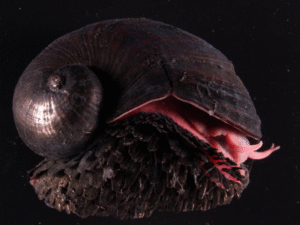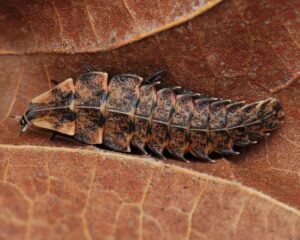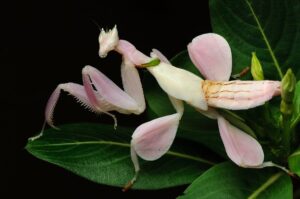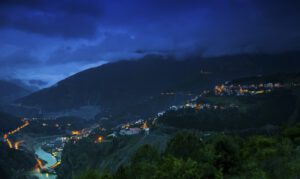Water hyacinth (Eichhornia crassipes) is a floating aquatic plant native to South America, but it has become widespread in India. While often seen as an invasive species, water hyacinth has numerous practical uses in India, contributing to environmental sustainability and various economic activities.
 Pin
Pin Image by Pam Caley from Pixabay
Table of Contents
Ecological Benefits
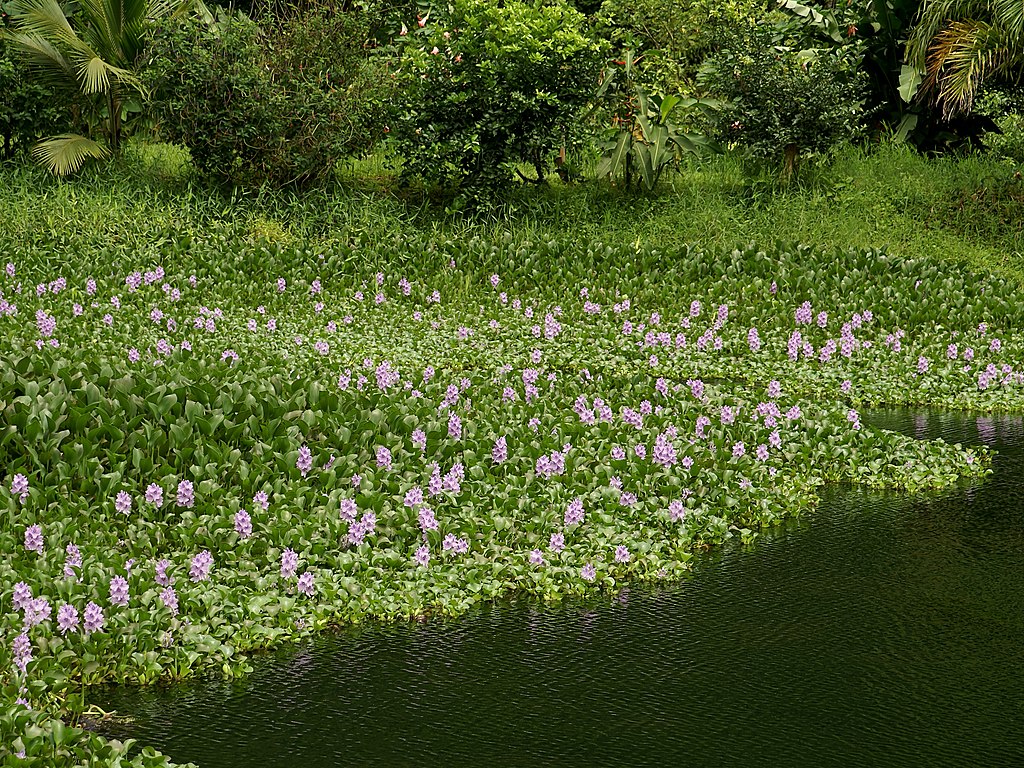 Pin
Pin Image from Wikimedia Commons
Water hyacinth (Eichhornia crassipes) serves multiple ecological functions that are vital for the health of aquatic environments. One of its primary benefits is its capacity to enhance water quality. The plant thrives in nutrient-rich waters, where it absorbs excess nutrients such as nitrogen and phosphorus. By doing so, it mitigates problems related to nutrient runoff, which can lead to algal blooms and subsequent oxygen depletion in water bodies.
Water hyacinth acts as a natural filter, capturing contaminants, sediments, and heavy metals. This filtration mechanism aids in maintaining the clarity and safety of aquatic ecosystems. The dense mats formed by water hyacinth provide a habitat for various aquatic organisms, including fish, amphibians, and invertebrates. This not only enhances biodiversity but also stabilizes the ecosystem, offering shelter and breeding grounds for numerous species. The presence of this plant indicates a rich ecological habitat, contributing to the overall health of aquatic environments.
Wastewater Treatment
 Pin
Pin Image from Wikimedia Commons
In India, the use of water hyacinth in wastewater treatment is gaining traction as an innovative and sustainable approach. This plant’s natural properties make it particularly effective for removing harmful substances from polluted water bodies. Its expansive root systems absorb nutrients, heavy metals, and pathogens from wastewater, thus improving water quality significantly.
Water hyacinth is a cost-effective alternative to traditional wastewater treatment methods, which often require substantial financial investment and energy consumption. This biological approach not only reduces operational costs but also minimizes environmental impact. By employing water hyacinth for wastewater treatment, communities can address pollution in an eco-friendly manner, promoting a cleaner ecosystem. Moreover, incorporating this plant into local waste management practices supports sustainable development goals, as it aligns with efforts to create greener, more resilient urban environments.
This method encourages public awareness about the significance of native plants in environmental management and showcases the potential of integrating bio-remediation techniques in tackling pollution challenges. Consequently, the implementation of water hyacinth in wastewater treatment aligns with broader environmental goals, fostering long-term ecological health and promoting biodiversity conservation.
Fertilizer Production
 Pin
Pin Image by Komang Kamartina from Pixabay
In India, the agricultural community is increasingly acknowledging water hyacinth as a valuable green manure. This aquatic plant, often viewed as a nuisance, possesses remarkable properties when decomposed. The decomposition process enhances the soil’s nutrient profile, particularly in terms of nitrogen and phosphorus content, both of which are essential for plant health and growth. As farmers integrate water hyacinth into their crop management practices, they observe improved soil structure and increased moisture retention, leading to healthier plants and ultimately better crop yields.
The application of water hyacinth as a fertilizer aligns well with the principles of organic farming. In an era where there is heightened awareness of the adverse effects of chemical fertilizers—such as soil degradation and water pollution—farmers find water hyacinth a sustainable alternative. Its use mitigates reliance on synthetic fertilizers, promoting a more eco-friendly approach to agriculture. Additionally, incorporating water hyacinth into farming practices supports biodiversity by fostering beneficial microorganisms in the soil, which can further enhance plant growth and resilience.
Craft and Handicrafts
 Pin
Pin Image source: akurat.co
Water hyacinth’s fibrous structure lends itself well to a diverse range of handicrafts. Artisans in India skillfully transform the plant into various products, including baskets, mats, decorative items, and even furniture. This craft represents a blend of functionality and artistic expression, with each piece often reflecting traditional designs and techniques passed down through generations.
The cultivation of handicrafts from water hyacinth has significant socio-economic implications. By engaging in this eco-friendly craft, artisans not only establish sustainable livelihoods for themselves but also contribute to the preservation of cultural heritage. The craftsmanship involved in creating these items showcases the artistry of local communities, while also addressing environmental concerns related to water hyacinth’s invasive growth.
These handcrafted products are increasingly sought after in both domestic and international markets. Their market appeal lies not only in their aesthetic value but also in their sustainability. As consumers become more eco-conscious, the demand for products made from natural, renewable materials like water hyacinth continues to rise. This trend not only promotes fair trade practices but also encourages sustainable production methods, fostering an appreciation for traditional crafts that are both environmentally friendly and economically viable.
Biofuel Production
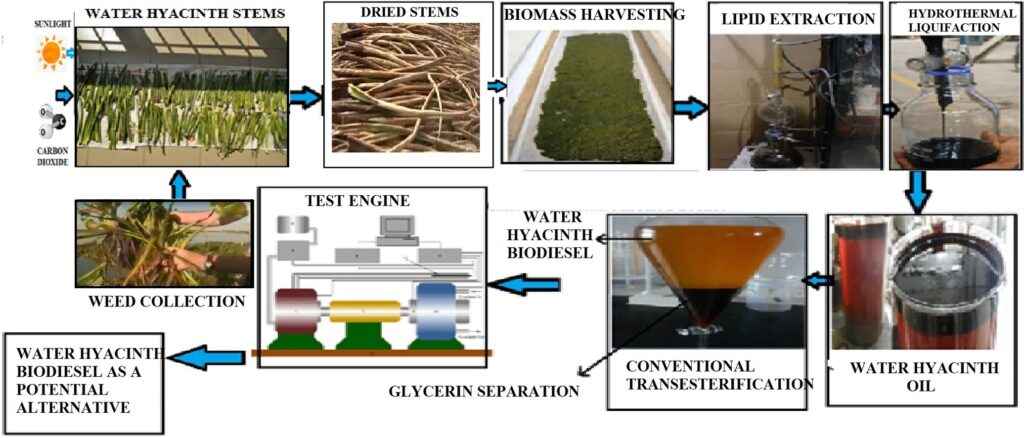 Pin
Pin Image source: sciencedirect
Water hyacinth (Eichhornia crassipes) is an aquatic plant that has garnered attention as a potential source for biofuel production. Its high biomass yield and rapid growth rate make it a promising candidate for renewable energy generation, especially in regions like India, where the energy demand is on the rise. India faces significant energy challenges, including dependence on fossil fuels and the accompanying environmental concerns. By converting water hyacinth into biofuel, we can establish an innovative energy source while simultaneously addressing these issues.
The biofuel production process typically involves harvesting the water hyacinth, which can be collected from water bodies where it thrives. Following collection, the plant material undergoes processes like anaerobic digestion or fermentation to produce biogas or bioethanol. These methods result in a renewable energy source that can be utilized for cooking, heating, and electricity generation. Using waste plants like water hyacinth addresses two critical issues: it reduces the biomass that clogs waterways, causing ecological disruptions, and it mitigates the energy crisis by supplementing traditional fuels with sustainable alternatives.
Biofuel production from water hyacinth can contribute to carbon footprint reduction, as it entails lower greenhouse gas emissions compared to conventional fossil fuels. This approach aligns with India’s commitment to increasing its share of renewable energy and decreasing reliance on non-renewable sources. Harnessing water hyacinth for biofuel not only addresses energy shortages but also promotes environmental sustainability.
Commercial Fish Farming
 Pin
Pin Image source: Wikimedia Commons
Water hyacinth plays a vital role in enhancing aquaculture through its unique properties. The plant provides cover for fish, creating a protective habitat that helps reduce stress levels and encourages natural behaviors. This cover is essential for young fish, which often need refuge from larger predators. Water hyacinth contributes to improved oxygen levels in aquatic environments, which is critical for fish survival and growth.
The presence of water hyacinth in fish farming systems can lead to increased fish populations and healthier stocks. It aids in nutrient cycling and can even help manage water quality by absorbing excess nutrients, thereby reducing algal blooms and promoting clearer water. Fish species thrive in these enriched environments, leading to better yields for fishermen.
Economically, enhanced fish yields directly benefit local communities that rely on aquaculture for their livelihoods. By integrating water hyacinth into commercial fish farming practices, not only can fish production be optimized, but it can also foster sustainable fishing practices. This symbiotic relationship between aquatic plants and fish farming drives local economies while supporting environmental preservation.
Educational and Research Purposes
Water hyacinth (Eichhornia crassipes), noted for its rapid growth and proliferation, serves as a vital subject for various scientific disciplines. Educational institutions across India have recognized its significance, engaging in extensive research initiatives focused on invasive species management, environmental conservation, and the development of sustainable practices.
Researchers study water hyacinth to understand its ecological impact, particularly its ability to outcompete native flora and disrupt aquatic ecosystems. Investigating its propagation patterns helps develop effective management strategies, enabling better control over its spread. This research is crucial for preserving biodiversity in water bodies where these invasive plants thrive.
Water hyacinth’s role in environmental conservation is explored through its natural ability to absorb pollutants, including heavy metals and excess nutrients. Educational programs focus on harnessing this trait for bioremediation, where water hyacinth is utilized in wastewater treatment processes. Such studies contribute to innovative environmental solutions, making it easier to address pollution in rivers and lakes.
Sustainable practices involving water hyacinth have also garnered attention. Institutions conduct experiments on converting this abundant plant into useful products, such as compost, textiles, and biofuels. This creates a dual benefit: mitigating the invasive nature of water hyacinth while generating sustainable materials. By focusing on the economic feasibility and environmental benefits, educational research lays the groundwork for incorporating water hyacinth into circular economy models.
Collaboration between universities, local communities, and governmental organizations is encouraged to foster knowledge exchange and practical applications. Workshops and seminars facilitate discussions on the latest findings, ensuring that research outcomes contribute to real-world solutions. By training students and budding researchers in these areas, institutions are preparing the next generation to tackle environmental challenges innovatively.
Conclusion
Water hyacinth presents significant challenges as an invasive plant in India, its multifaceted uses underscore its potential for positive impact. By recognizing and capitalizing on its applications in wastewater treatment, agriculture, crafts, biofuel production, and aquaculture, India can transform a problematic species into a sustainable resource. Embracing these strategies paves the way for greener practices and economic growth, ultimately fostering a more sustainable future. Such initiatives will not only address ecological concerns but also enhance rural livelihoods, creating a holistic approach to environmental management.












